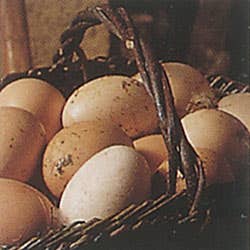
Egg Basics
If you’ve ever wondered, here’s everything you need to know about eggs and more.
THE COLOR OF EGGS: In Massachusetts, Rhode Island, and Maine, the vast majority of the eggs consumed are brown-shelled. The rest of the country prefers white shells. Why do some egg-lovers prefer brown? It's a question of perception. White is an industrial color, suggesting sterility and artificiality. Brown is homey, earthy. Brown eggs thus seem somehow fresher, more wholesome, more genuine.
Well, sorry, but the difference between brown eggs and white is only shell-deep—a difference determined by the breed of hen that lays them. (Leghorns lay white, for instance, and Rhode Island Reds lay brown.) What's inside the eggs is what counts, and that's determined mostly by what the hens are fed.
MAKING THE GRADE: The grade of an egg has nothing to do with its freshness; it is a rating of appearance. An egg with a clear, tight white and well-defined firm yolk will be graded AA. One with a slightly thinner white and weaker yolk membrane gets an A. The condition of an egg's interior is determined by "candling," or placing it in front of a light source—more likely an electronic device than a candle these days. Eggs with flat yolks, thin whites, and stained or misshapen shells are marked grade B, the lowest quality.
SIZE MATTERS: Not all eggs must be graded, but all must be sized—labeled as "Jumbo," "Extra-Large," "Large," or "Medium." (There are also "Small" and "Peewee" eggs, but these are rarely offered for commercial sale, but reserved for mixes.) Size is not necessarily a reflection of quality, but it does make a difference in recipes, since the amount of egg you are adding to a dish may vary widely depending on its weight.
Keep Reading
Continue to Next Story










